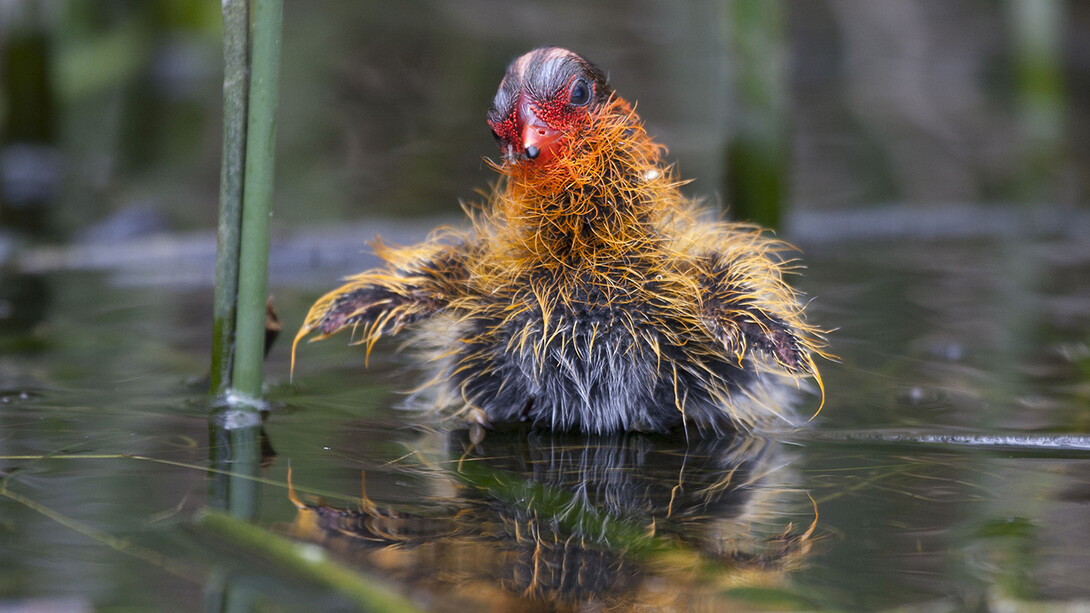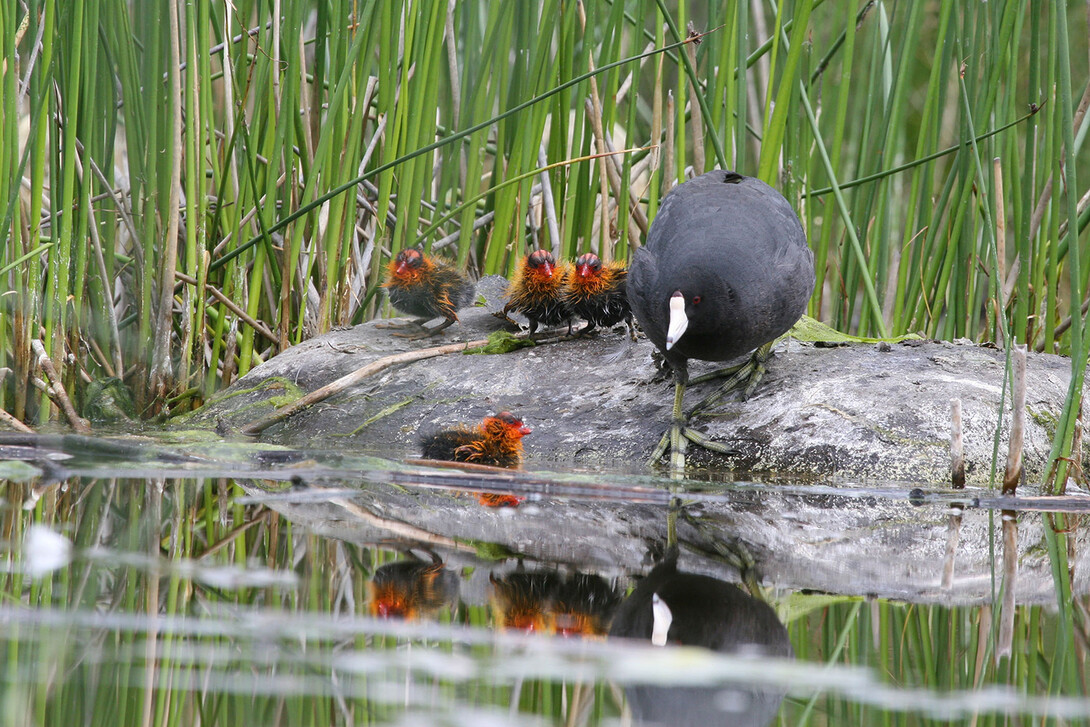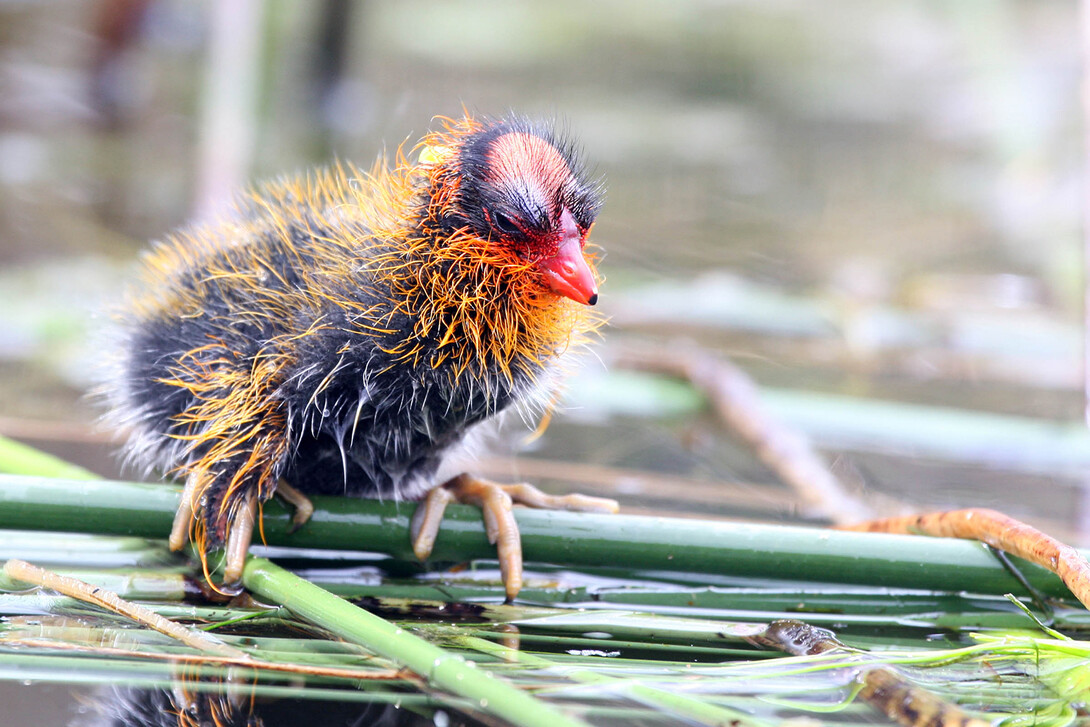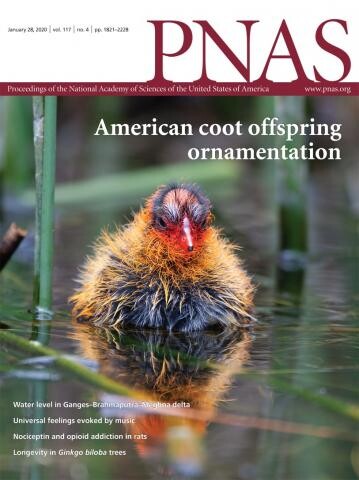
Some American coot chicks emerge from the egg looking ready to set the nest ablaze.
A near-bald, seemingly singed crown reveals a pink scalp above a deep-red beak and, below that, a throat and breast covered in wispy feathers of lighter red and Cheetos-dust orange.
“Some are just full-blown orange puffballs,” Daizaburo Shizuka, assistant professor of biological sciences at the University of Nebraska–Lincoln, said of the young waterbirds.
The reason for the fiery ornamentation had eluded Shizuka and his former doctoral adviser, Bruce Lyon, an ecologist at the University of California, Santa Cruz. That ornamentation was especially confounding because some of the chicks hatch wearing duller, yellower hues and more closely resemble their parents, which sport charcoal feathers and white beaks. Such flamboyance, usually reserved for adult male animals that are peacocking for love, also makes the chicks more visible to potential predators.

Yet the rules of natural selection insisted that the coloration must benefit either the offspring or their parents. A recently published study from Lyon and Shizuka suggests that the ornamentation acts as a sort of color-coded guide to parenting — and that redder is better, with the parents, if not fortune, favoring the bold.
Redder late than ever
American coot chicks face dire odds; roughly 50% of a brood perishes within 10 days of the last egg hatching. But predators can’t take credit. The blame instead lies with a common, if cold, evolutionary logic. Laying up to one egg per day, the female coot typically nests eight to 10 total — more than the parents could likely ever feed. The number they can support, though, depends on multiple factors that can vary by year. Having a surplus of offspring, then, can mean extra survivors in bountiful years.
Their mortality rate belies the fact that young coots are precocious, plopping into the water to swim after their parents within hours of hatching. For the first 10 days, the parents effectively feed their chicks on a first-come, first-served basis. Then, after multiple starvations, the status quo changes: Each parent begins favoring an ornamented chick with most of its food while weaning the others, usually the duller-feathered, by yanking them away as necessary.
That behavior pointed to a potential purpose for the pigment. Lyon and Shizuka suspected it might stem from a phenomenon called brood parasitism, whereby a female coot will sometimes lay an egg or two in the nest of another. Maybe, they thought, females lay eggs housing the redder chicks in neighboring nests as a way of duping other parents into feeding them, essentially adopting them out while focusing on those remaining in their own nests.
“Honestly, I thought that was what we were going to find,” Shizuka said. “But it wasn’t true.”

When the researchers tracked the so-called parasitic eggs, they saw instead that the chicks emerging from those eggs were less vibrant than the chicks of the host mother. So the researchers considered another hypothesis. Prior research showed that about two-thirds of the chicks favored by parents were also among the last to hatch. Lyon and Shizuka, in turn, decided to look for a relationship between the coloration of chicks and the order in which their eggs were laid.
Fortunately, their team was already collecting, incubating and cataloging more than 1,400 American coot eggs in British Columbia. Each time a chick hatched, the researchers would quantify its color by measuring how each wavelength of the visible spectrum reflected from the feathers, then correlate its coloration with its place in the egg-laying order.
A chronological gradient soon revealed itself: Compared with their early-hatching, yellower siblings, the late hatchlings — the youngest and often smallest of the brood — arrived fashionably in vibrant reds and oranges.

Given that older, less-vibrant chicks generally outrace their younger siblings to meals in the free-for-all feedings of the first 10 days, the findings suggest that the ordered ornamentation helps coot parents identify and remember which survivors need pampering in the aftermath. The team’s follow-up observations — recorded from floating blinds built on tractor-borrowed inner tubes — confirmed that parents favored the vibrant chicks more often than would be expected by chance. And the redder the chicks were, the more likely they were to receive preferential feeding.
But the researchers were in for another surprise: The ornamentation doesn’t actually seem to improve the vibrant chicks’ odds of survival. Why not?
“I think the simple answer is that which chicks live and die has been decided already by the time that parents have started to choose favorites,” Shizuka said. “After you survive the first 10 days, your probability of continuing to survive is fairly flat.”
Though the surviving runts are through the worst, they still need plenty of help to continue growing, Shizuka said. Larger chicks manage to start diving underwater for dragonfly larvae and other nutrient-rich prey. By contrast, their colorful siblings often seem to struggle doing the same, he said, sometimes subsisting on pond scum or other less-hearty surface fare.
“At that point, there’s a huge disparity in the size and condition of the chicks,” Shizuka said. “The last-hatched chicks are much smaller by then, and they are not able to independently feed.
“In the beginning, they’re like buoys. As hard as they try, they cannot get underwater. They need to develop a certain amount of muscle mass, probably, to be heavy and powerful enough to actually dive and get the food that they want. I think that’s where (parental help) matters most.”
Shizuka said questions remain. One arose when the team assembled artificial, multi-family broods of chicks that all hatched within 48 hours, rather than across the typical week. After transplanting the similar-aged “siblings” back to a single nest, the team found that the connection between coloration and preferential feeding disappeared.
“This is a big puzzle,” he said. “All we can really surmise right now is that (staggered hatchings and coloration) are coupled. One doesn’t seem to function well without the other. Something doesn’t match up.”
The eye-straining vibrancy of the plumage — especially compared to the relatively subdued hues of other coot chick species — likewise has the researchers at a loss, at least for now.

“We’ve been able to show how color in the species seems to work,” Shizuka said of the recent study, published in Proceedings of the National Academy of Sciences. “But that still doesn’t really answer for me why they’re so bright.”







